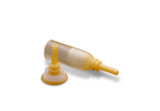Medical Catheters for Sale:
What is a catheter?
Catheters are medical devices that are used to assist people who have difficulty controlling their bladder function. They come in various forms including thin tubes that are inserted into the body or are external devices that are worn on the outside of the body. All catheters must be sterile to prevent infection, and it's essential to seek medical advice when deciding on a catheter.
What are the three types of catheters?
The three main types of catheters are intermittent catheters, external catheters, and foley catheters.
Intermittent catheters
Intermittent catheters are thin tubes that are temporarily inserted to drain the bladder of people with urinary retention. Once the bladder has been emptied, the catheter should be removed and thrown away. These in and out catheters are available with a standard straight tip, or an angled tip known as a coude style. The bent tip of a coude catheter helps navigate around an enlarged prostate or urethral obstructions. Intermittent catheters come in various lengths and diameters to fit each person's anatomy. The diameter of the catheter is referred to as the French size. Men have to use longer catheters in order to reach the bladder. The female urethra is not as long as a male, so women have the choice of using a short catheter or full-length catheter. You can also choose hydrophilic catheters that are pre-lubricated, or you can use an uncoated catheter and pair a separate lubricating jelly with it. With advancements in self-catheterization, catheter insertion has become more comfortable thanks to brands like Rusch, Cure Medical, Medline, Hollister, and Coloplast.
External catheters
External catheters, also known as condom catheters, are one-piece molded sheaths that go around the shaft of the penis. These are used by men with urinary incontinence as an alternative to adult diapers. A leg bag or collection bag is worn in conjunction to collect the urine that drains from the catheter. You have the choice of connecting the bag directly to the end of the catheter or using extension tubing if you'd like to wear the bag lower on your leg. Some condom catheters have a gentle adhesive on the inside of the sheath to keep it in place throughout the day. Another option is to attach an external catheter to the body using an adhesive foam strip. We carry external catheters that are transparent, which allows you to monitor the condition of your skin while wearing the catheter. If you are new to cathing, please see our blog on how to use a condom catheter.
Another type of external catheter is known as a Texas catheter. This three-piece style consists of a thin sheath, a silicone tube, and a connector to direct urine from the penis. The sheath of a Texas catheter tends to be thinner and more flexible than that of a molded external catheter. Texas catheters do not have an adhesive on the inside of the sheath. Therefore, you will need to use a medical grade adhesive to keep it secure. Some men also use an adhesive foam strip to secure the catheter around the penis. Express Medical Supply carries a variety of Texas catheters from brands like Covidien Dover and Urocare.
Foley catheters
Foley catheters are an indwelling catheter that stays in the body for a longer period of time, up to several days or weeks. Foley catheters are often used after surgeries or by people who are confined to bed. A foley catheter has a hollow balloon on one end. After the balloon is inserted into the body, it is filled with sterile water. This helps keep the catheter in the proper position and prevents it from coming out. When the catheter is ready to be removed, the balloon is deflated. While the foley catheter is in use, a drainage bag will need to be connected to the end of the foley catheter to collect urine. One popular supply that is used along with this type of catheter is a foley catheter securement device. These catheter stabilizers are adhesive pads with a small clamp that the catheter tube sits below for protection. They prevent the catheter from being pulled on or becoming dislodged, which can cause pain and urethral damage.
Each one is meant to treat different urological conditions. Be sure to consult with your healthcare provider to determine which catheter is appropriate for your needs.
What is a catheter used for?
Urinary Catheters can be used to treat two types of urological conditions, urinary incontinence and urinary retention. Urinary incontinence is involuntary urine leakage. Urinary retention is the inability to empty the bladder entirely. Some catheters are inserted into the urethra, such as intermittent catheters and foley catheters. Others are worn on the outside of the body, such as condom catheters. Catheters can be made of various materials such as latex, silicone, or red rubber. They are also available in a variety of sizes to fit each person's body and help them work properly. It is important to follow your doctor's instructions when choosing a catheter style and size to avoid complications.
How does a catheter work?
Each type of catheter works a bit differently. Intermittent catheters and foley catheters are both inserted through the urethra and into the bladder to drain urine. External catheters are used by men and are worn on the outside of the penis. A catheter bag connects to the external catheter to collect urine.


























